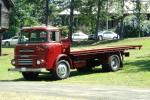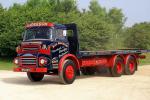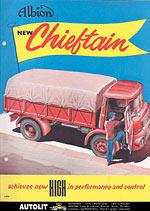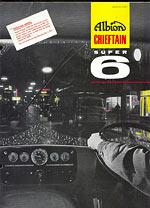Albion » CH / CD / RE / CA with LAD cab
CH3. 1958-1967. In addition to the new hub reduction axle, the new CH3 Chieftain 7 ton lorry incorporated a revised 4 cylinder 5.5 litre engine, now renamed EN289, which produced more power and better fuel consumption. An Albion 5 or 6 speed constant mesh gearbox and Clayton Dewandre vacuum assisted hydraulic brakes completed the specification. All new models now were equipped with the Motor Panel LAD cabins. Later was presented CH3A model with an upgraded EN335 engine.
CH7. 1960-1967. The full line up of LAD cabbed models was completed in 1960 when the CH7TR 'Chieftain-Scammel' tractor chassis made its appearance and replaced FT111KR.
CH13/CH17. 1962-1972. The Leyland engined Chieftains were called the Chieftain 'Super Six' and there were two basic models, the tipper/haulage CH13, and the CH17 tractor unit.
CH51. 1967-1969. A decision had been taken by 1965 to end engine manufacture at Scotstoun, and by 1966 the only engine remaining in production which was fitted to an Albion was the 5.5 litre EN335 unit. To maintain the choice of two engines in the Chieftain range when engine production was finally ended in 1967, changes of the specification of the 'Chieftain Super Six' CH13 and CH17 were announced in 1967. The 0.370 engine was replaced by the 0.400 engine in these trucks, but was then reintroduced in November 1967 in an ostensibly new model, the 'Chieftain 51'. This new model, designated CH51, effectively replaced the CH3.
CH53. 1967-1969. Tractor truck on the chassis of CH51 received the designation CH53.
CD21. 1958-1972. The new Clydesdale for 1958 was designated CD21, and could be differentiated from the Chieftain by use of 10 stud wheels. Albion engines were no longer available in the Clydesdale, and the Leyland 0.375 of 6.17 litres capacity was now the only engine offered. A new version of the five or six speed constant mesh gearbox was used. By June 1959 eleven models were offered in the Clydesdale range, which included eight haulage and two tipper models, all available in varying wheelbases, and in widths of 7'6" or 8'.
RE27. 1959-1967. The LAD cab and hub reduction axle were introduced on the Reiver in February 1959 in the form of the RE27, a 6x2 chassis with trailing read axle and larger Leyland 0.375 engine. The specification was otherwise similar to the CD21 'Clydesdale' except that the Reiver used eight stud wheel fixing on the front axle.
RE25. 1959-1965. By May 1959 the RE25, the 6x4 version of the Reiver was ready. In tipper form these Reivers quickly gained a reputation among contractors as a dependable and useful workhorse. Much of this reputation was due to the Albion designed non-reactive suspension on the rear bogie. Another novel feature of the double drive chassis was the way the drive was transmitted to the rear bogie. Since the design of the spiral bevel axle does not permit the propeller shaft to pass straight through the bevel drive unit, the drive from the five or six speed constant mesh gearbox was transmitted to relay gearbox which was situated midway in the chassis.
RE29. 1961-1972. In September 1961 came the 'Super Reiver' RE29, a heavier duty version of the RE25, with heavier rear springs and axles, chassis frame reinforced with flitch plates, air brakes replacing hydraulics, and lighter steering despite its greater weight. The Leyland 0.400 engine was fitted, having become standard in the Reiver and Clydesdale the previous year.
RE31. 1962-1972. The version of RE27 with Leyland 0.400 engine received designation RE31.
CA81. 1968-1972. The fifth and last eight wheel model emerged from Scotstoun in August 1968 in the shape of the Cameronian CA81, which was effectively Reiver with a 4th axle. Although designed for operation in Australia for use with the Dumpmaster, three examples did enter service in Scotland with Russell of Bathgate with bulk grain bodies. These trucks could haul the 24 ton GVW vehicles.




































